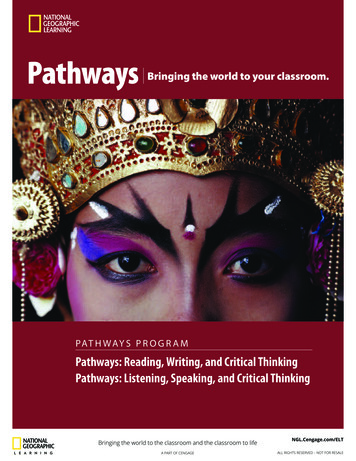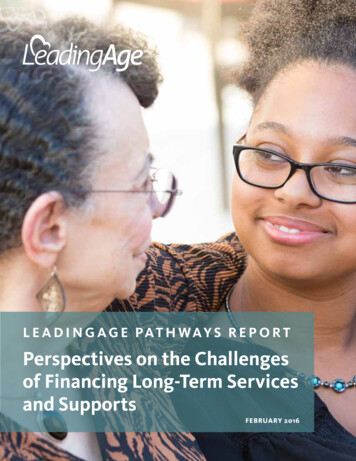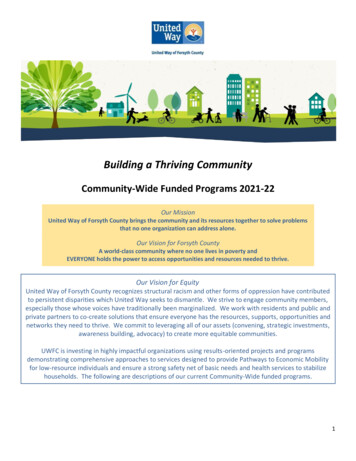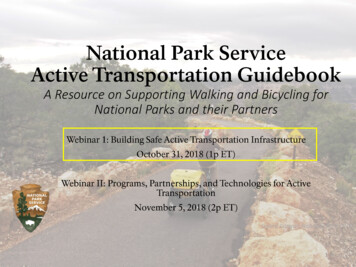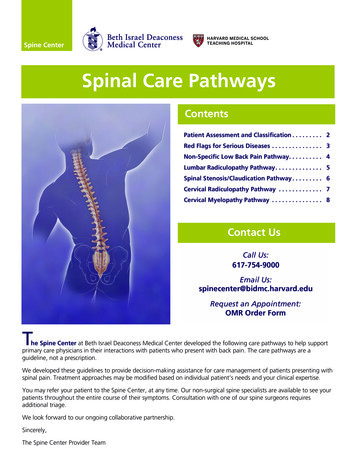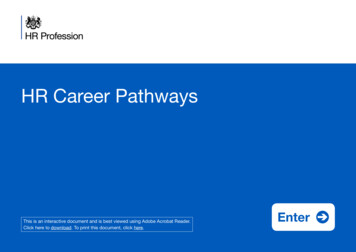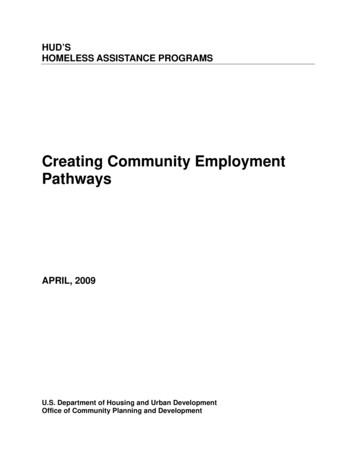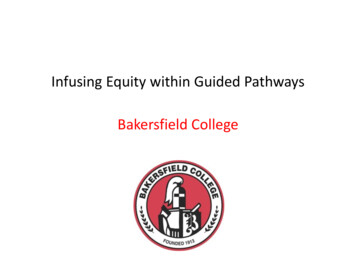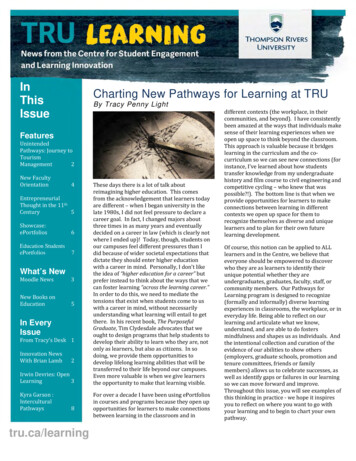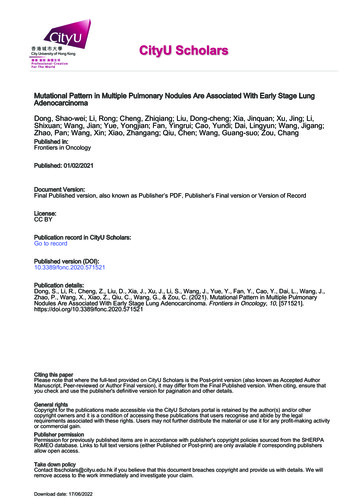
Transcription
Agenda1. M-CAM Overview2. Types of Industry Credentials Selected3. Processes Used to Articulate Credit4. Lessons Learned in Articulating Credit5. Next Steps
M-CAM Colleges 2013 Round 3 DOLTAACCCT Grant Eight colleges in MI Rural/suburban mix Geographically disperse
What is M-CAM?Round 3 DOL TAACCCT Grant totaling 24.9 millionTotal Grant AmountSchoolcraft CommunityCollege 1,107,377Lake Michigan College 1,217,576Bay de Noc CommunityCollegeLansing Community College 2,114,000 2,655,476Mott Community College 2,688,000Macomb CommunityCollege Other colleges took lead incertain pathway areas 1,473,249Kellogg Community CollegeGrand Rapids CommunityCollege Macomb served as leadcollege 4,128,382 9,615,803
M-CAM Goals Align technology with industry standards Develop, real-time longitudinal student database Enhance coordination and build capacity across 8 colleges Improve student access to career advising and job placementservices Address current and future job /competency-models/advanced-manufacturing.aspx
M-CAM Career Pathways Focus Four advanced manufacturing pathways CNC Machining Welding/Fabrication Multi-Skilled Technician or Mechatronics Production Operations
M-CAM Educational Pathways Multiple On Ramps
“Big Audacious” Goals Under M-CAMPriority #1: CreditPriority #2: Non-Credit 4-yr institutions: Award of 30 Develop non-credit to creditcredits for Associate students M-CAM colleges: Articulationagreement with individualcourses that transfer across MCAM collegescrosswalks for all four careerpathways Under PLA, identify credit thatcan be awarded for noncreditcourses Identify credit that can beautomatically awarded tononcredit students
Scope—Enrollment Overall and By PathwayEnrollment by CollegeNumber of Participants and Percent of Enrollment Target Reached1,348946Enrolled255%of Target667Enrollment by Career Pathway33%Non-Credit111%of lled40%Non-Credit507133%of Target205192103%of Target110%of Target396397137%of Target103%of Target62%Non-Credit213118%of RapidsKelloggLakeLansing ledProductionWelding/Fabrication
Articulation Task and Planning Process
Certification Selection ProcessWhat do employers need? What certifications are employers using? Colleges conducted employer surveys across each of the fourpathways to identify skills and competencies Colleges worked collaboratively with oneanother and within their colleges Across each pathway, faculty, grant staff andThe certificationselection processtook a lot of time. So,plan accordingly.business representatives met Faculty reviewed and tested industry certifications After grant end, faculty continue to meet to discuss curriculum andcertifications
M-CAM Faculty Roles Identified industry certifications based on industryneeds and college programs Took assessments Participated in training on assessment toolsand curricula Redesigned some courses to better align tocertifications
Aligning Programs to Industry Credentials
Credentials Incorporated into PLA Process
Credentials Incorporated into PLA Process All M-CAM colleges had PLA processes Align programs/coursework with 3rd party certifications outcomes toeach individual college’s PLA processes and procedures May look different depending on M-CAM college
Forums/Discussions on PLA Ensued Creation of cross-college forum to address PLA methods andprocedures Many M-CAM colleges adopted new methods for PLA in advancedmanufacturing programs Bay College created new PLA policies Lake Michigan used CAEL’s Learning Counts Grand Rapids took a novel approach M-CAM colleges actively promote PLA to their manufacturingstudents—both credit and noncredit– and employers
M-CAM Articulation Signing
Refocused the Discussion18 Changed discussion betweennoncredit and credit programs Program(Noncredit &Credit)Traditional focus on training hoursversus classroom hoursWeldingAmerican Welding Society (AWS)New focus on competenciesCNC MachiningNational Institute forMetalworking Skills (NIMS)Multi-SkilledPackaging MachineryManufacturers Institute (PMMI)and/or SiemensProductionManufacturing Skills StandardsCouncil (MSSC) Used national assessments tovalidate competencies CertificationStudents earn credentials thattranslate into academic credit
Grand Rapids TAACCCT Experience GRCC’s Academic Governance Council approved articulatingfrom industry credential direct to class credit Student does NOT need to go through PLA process or pay addt’l money Use of industry credentials goes beyond manufacturing, includes healthcare Resulted in easier process for students Creation of Transfer equivalency system Students can see what has already beenarticulated from other colleges (and articulation
GRCC Policy on National Credentials
The Secret Sauce in Grand Rapids Competency-based Nationally validated credentials
OSHA 10 Hour SafetyCertification
Lessons Learned Agreement must be driven by faculty and deans Obtain faculty buy-in early on in the process Aligning some pathways to industry credentials difficult Some employers do not experience with industry certifications Help employers see value of students with credentials Important to have host college award credit Easy to have credits transfer to another college Host faculty know their own curriculum
Lessons Learned cont. Build buy-in among everyone faculty, students, employers,workforce partners Create a “champion” or PLA Lead Create a public outreach and awareness campaign Bridge divide between noncredit and credit programs Focus on where enrollments occurs; noncredit a pipeline for credit Grand Rapids found noncredit students entered workforce quickly and had away to pay for college credit programs
Lessons Learned cont. Simplify the process Build industry credential assessments into courses Negotiate price reductions with third-party assessment organizations Become an assessment center Create a tracking system to document use Use in noncredit and credit programs Use in different training/program areas Student demographics Credential completion rates
Contact InformationJulie ParksExecutive Director Workforce TrainingGrand Rapids Community Collegejparks@grcc.edu616-234-3714 P
Bay Grand Rapids Kellogg Lake Michigan Lansing Macomb Mott School-craft 205. 103% of Target. 667. 111% of Target. 507. 133% of Target. 192. 110% of Target. 396. 137% of Target
